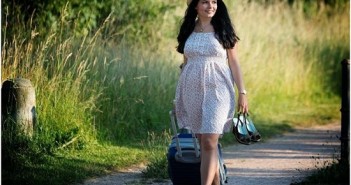 Courtesy of The World Pursuit
Courtesy of The World Pursuit
And after two dates, they decided he would go with her.
More than three years later, Alden and Cameron Seagle are still traveling together. They've backpacked Europe, Southeast Asia, and now, they're spending a year driving across Africa.
In all, the 20-somethings have been to about 50 countries. You can follow their adventures through their site, The World Pursuit, and their Instagram.
Below, they told Business Insider how they saved up about $50,000 to fund their travels, why they're driving across a continent, and what it's like to travel the world together.
On that first post-graduation trip abroad, Alden and Seagle met in Norway and traveled together for two months, using money they'd saved from weekend and summer jobs throughout college.
In Norway.
Then, Seagle returned home to the US as Alden kept at it. After six months at home, he flew back out to meet her again in Southeast Asia.
Backpacking through Bangkok, Thailand.
They spent two months together in Asia, then moved to New York City to fill their coffers for longer-term travel.
At Storm King sculpture park in New York.
"We didn't have an apartment, we didn't have jobs ... we didn't have anything, really," says Alden. "We just wanted to move to New York because that's what people want to do." However, they had an end goal: Save enough money to take off once again — planning to spend about $1,000 per person, per month.
Hiking in Nis, Serbia.
They were able to get steady jobs in the film industry, and a small apartment in the Bronx. They took second jobs and buckled down, eating in, passing up nights out, and signing up for checking accounts, savings accounts, and credit cards that offered incentives in the form of cash or miles. They put their retirement savings on hiatus, diverting any contributions to their travel fund.
Paragliding over Lake Ohrid, Macedonia.
Editor's note: If you're going to open financial products for the financial incentives, make sure you aren't signing up for fees — like low-balance fees on a checking account or annual fees on a credit card — you can't handle. Always read the fine print before signing on the dotted line.
It is always recommended that you contribute to your retirement accounts as best you're able.
"It wasn't hard, at least not for me," says Alden. "I had this goal: I knew if I lived below my means now, I could experience what I wanted later."
Swimming with whale sharks in Tofo, Mozambique.
"We could have afforded a nicer apartment," says Seagle. "The biggest thing was that whatever I save now I can spend later. A $100 meal in New York can give me three or four days in the world, traveling."
Jumping into the Mediterranean off the coast of Greece.
After a year, their lease was up and they'd saved a collective $50,000. They booked the cheapest transatlantic flight they could find — $240, one-way tickets to Latvia — and left town in the spring of 2015.
Leaving New York for Latvia.
They spent the next year traveling through Europe, the most expensive destinations they planned to visit — including Latvia, Lithuania, Poland, Cyprus, Turkey, Italy, Morocco, Slovenia, Serbia, Macedonia, Montenegro, Croatia, Greece, and the Seychelles — while their savings were still full.
In Istanbul, Turkey.
Today, they're six months into a year-long drive across Africa, which they began in July in Johannesburg, South Africa.
In Etosha National Park, Namibia.
They're still living off their savings. But between affiliate links on their site, social media takeovers for brand and destinations, and freelance writing and photography, they've managed to generate about $2,000 a month of income.
On Lake Kariba, Zimbabwe.
They try not to spend more than $40 a day per person. Usually, it's easy. "In a lot of parts of the world you can get a nice Airbnb rental, have a coffee — you don't have to live bare bones on $1,000 a person," says Alden.
At Tongabezi Lodge, Zambia.
They bought a Land Cruiser, and in a typical day they spend a considerable amount of time driving. They're currently in Malawi, where they spend the day "chatting with locals, having coffee, and going on the lake," says Alden. "We like to go hiking and see the sights."
In Malawi.
"With the car, we can go anywhere we want," says Alden. "We wanted to go to these unknown destinations that the typical tourist doesn't get a chance to get to."
Diving with sharks in Capetown, South Africa.
"Some days, we'll be driving and get online for a little in the evening," says Seagle. "Or we've arrived somewhere and we're online during the day. When it's dark out we work, and when it's light we go out and enjoy the day."
Canyoning in Cape Town, South Africa.
Their travel isn't always smooth. Not only are they out of range for Google Maps, but they're driving on "some of the worst roads in the world," explains Seagle. When they got buried in sand up to the truck's chassis in the Okavenga Delta, "it was about three hours in the wilderness with lions and leopards and anything you can imagine, trying to dig it out in 100-degree weather."
Driving through Malawi.
Alden credits their ability to save enough for long-term travel to their resolution to set goals. "Because if you just say you want to do something but you're not setting goals to get there, you might never get there," she says.
At Tongabezi Lodge in Zambia.
"We actually have no immediate plans to return to the US," they write on their blog. "For the time being, we will continue to travel the world until we find a place to call home."
In Pafos, Cyprus.




